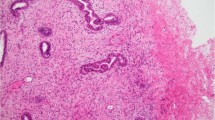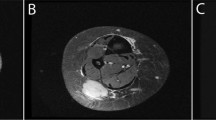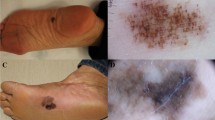Abstract
Myointimoma is an uncommon, benign soft-tissue tumor derived from the intimal cells of blood vessels. Since little is known about this rare tumor entity, our aim is to describe an additional case and to perform the first literature review on this topic. A 49-year-old Caucasian man presented with a 12-month history of a palpable, firm, solitary lesion involving the glans penis. On physical examination, there was a 1 cm palpable, endophytic well-circumscribed nodule located to the left side of glans penis, close to the coronal sulcus, with disease-free external urethral orifice. The patient was submitted to complete excisional biopsy. A skin rhombus measuring 1.1 × 0.8 × 0.3 cm was removed and the biopsy sample, fixed in 10% formaldehyde, sent to Pathology. At the 18-month follow-up visit, the patient was clinically disease free. Histopathology revealed a multinodular intravascular proliferation of the corpus spongiosum. This myointimal proliferation comprised bland predominantly spindle cells in an abundant fibromyxoid stroma. Immunostains for smooth muscle actin (1A4), cytokeratins (AE1/AE3, CAM5.2), and CD34 were carried out using the avidin-biotin complex (ABC) immunoperoxidase method. Lesional cells displayed positivity for smooth muscle actin and negativity for cytokeratins and CD34. Myointimoma is confirmed to be a penile benign lesion that may be adequately treated with excisional biopsy. Even after incomplete or marginal removal, the penile lesion has been shown to remain stable overtime or regress. Differential diagnosis is essential to exclude similar histologic entities that could be more aggressive or have possible systemic implications.
This is a preview of subscription content, access via your institution
Access options
Subscribe to this journal
Receive 8 print issues and online access
$259.00 per year
only $32.38 per issue
Buy this article
- Purchase on Springer Link
- Instant access to full article PDF
Prices may be subject to local taxes which are calculated during checkout

Similar content being viewed by others
References
Fetsch JF, Brinsko RW, Davis CJ Jr, Mostofi FK, Sesterhenn IA. A distinctive myointimal proliferation (‘myointimoma’) involving the corpus spongiosum of the glans penis: a clinicopathologic and immunohistochemical analysis of 10 cases. Am J Surg Pathol. 2000;24:1524–30.
WHO. Classification of tumors of the urinary system and male genital organs. Moch H, Humphrey PA, Ulbright TM, Reuter V, editors. Lyon: IARC; 2016.
Robbins JB, Kohler S. Penile nodule in a 54-year-old man: a case of a myointimoma. J Am Acad Dermatol. 2005;53:1084–6.
Vardar E, Gunlusoy B, Arslan M, Kececi S. Myointimoma of the glans penis. Pathol Int. 2007;57:158–61.
McKenney JK, Collins MH, Carretero AP, Boyd TK, Redman JF, Parham DM. Penile myointimoma in children and adolescents: a clinicopathologic study of 5 cases supporting a distinct entity. Am J Surg Pathol. 2007;31:1622–6.
Turner BM, Reith JD, Al-Quran SZ. Penile myointimoma. J Cutan Pathol. 2009;36:817–9.
Monsálvez V, Rodríguez-Peralto JL, Fuertes L, Garrido C, López-Gómez S. Myointimoma: a rare tumor of the penis. Actas Dermosifiliogr. 2009;100:511–2.
Tanriverdi HI, Yılmaz O, Neşe N, Taneli C, Genc A. Myointimoma of the glans penis. J Pediatr Surg Case Rep. 2019;44:101189. https://doi.org/10.1016/j.epsc.2019.101189.
Dehner LP, Smith BH. Soft tissue tumors of the penis. A clinicopathologic study of 46 cases. Cancer. 1970;25:1431–47.
Hey A. 2 rare nonepithelial benign tumors of the penis. Pathologe. 1984;5:286–8.
Montgomery EA, Fetsch JF. Tumors and tumefactions of peripheral vessels. In: Stebens WE, Lie JT, editors. Vascular pathology. London: Chapman & Hall Medical; 1995. p. 739–85.
Redman JF, Liang X, Ferguson MA, Savelli VH. Leiomyoma of the glans penis in a child. J Urol. 2000;164:791.
Val-Bernal JF, Garijo MF. Solitary cutaneous myofibroma of the glans penis. Am J Dermatopathol. 1996;18:317–21.
Enzinger FM, Zhang R. Plexiform fibrohistiocytic tumor presenting in children and young adults: an analysis of 65 cases. Am J Surg Pathol. 1988;12:818–26.
Hollowood K, Holley MP, Fletcher CDM. Plexiform fibrohistiocytic tumour: clinicopathological, immunohistochemical and ultrastructural analysis in favour of a myofibroblastic lesion. Histopathology. 1991;19:503–13.
Daimaru Y, Hashimoto H, Enjoji M. Myofibromatosis in adults (adult counterpart of infantile myofibromatosis). Am J Surg Pathol. 1989;13:859–65.
Chung EB, Enzinger FM. Infantile myofibromatosis. Cancer. 1981;48:1807–18.
Montgomery EA, Meis JM. Nodular fasciitis: its morphologic spectrum and immunohistochemical profile. Am J Surg Pathol. 1991;15:942–8.
Chi AC, Dunlap WS, Richardson MS, Neville BW. Intravascular fasciitis: report of an intraoral case and review of the literature. Head Neck Pathol. 2012;6:140–5.
Morales MM, Anacleto A, Leal JC, Carvalho S, Del’ArcoII J. Intravascular leiomyoma with heart extension. Clinics. 2012;67:83–7.
Salomao DR, Nascimento AG. Plexiform fibrohistiocytic tumor with systemic metastases: a case report. Am J Surg Pathol. 1997;21:469–76.
Author information
Authors and Affiliations
Corresponding author
Ethics declarations
Conflict of interest
The authors declare that they have no conflict of interest.
Additional information
Publisher’s note Springer Nature remains neutral with regard to jurisdictional claims in published maps and institutional affiliations.
Rights and permissions
About this article
Cite this article
Cito, G., Santi, R., Gemma, L. et al. Myointimoma of the penis. Int J Impot Res 33, 583–586 (2021). https://doi.org/10.1038/s41443-020-0316-7
Received:
Revised:
Accepted:
Published:
Issue Date:
DOI: https://doi.org/10.1038/s41443-020-0316-7



